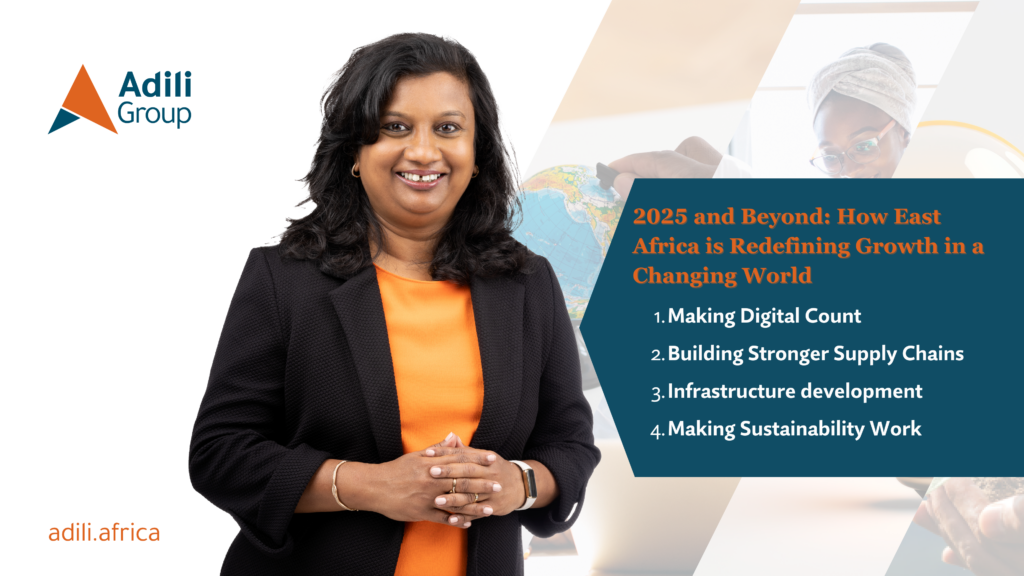East Africa economic growth.
East Africa is entering a transformative phase of economic expansion. With GDP expected to rise by 5.7%—leading all Sub-Saharan regions (East African Development Bank, 2024)—the market presents lucrative opportunities for well-prepared organizations.
But growth won’t come automatically. Businesses that succeed will be those that embrace digital innovation, resilient supply chains, urban infrastructure investments, and sustainability-driven strategies. Our research highlights four key areas that will define market leaders in 2025 and beyond.
Making Digital Count
Technology is reshaping industries across East Africa, with fintech, e-commerce, and AI-driven solutions leading the charge in transforming financial inclusion, customer experiences, and operational efficiency. However, digital transformation goes beyond simply adopting new technologies—it’s about driving tangible business value and creating competitive advantages.
Companies that actively embrace digital tools are growing 20-30% faster than those that don’t (Digital Economy Blueprint, 2024), underlining the importance of technology in fostering business success in the region. The key areas driving this transformation include:
- Fintech: East Africa has become a global leader in mobile money, with over $800 billion processed in transactions in 2023. M-Pesa (Safaricom) alone accounted for $314 billion (GSMA, 2024). This surge in mobile banking and payment solutions has revolutionized financial inclusion, providing millions with access to banking services for the first time.
- AI and Automation: AI is enhancing business efficiency in various sectors. A prime example is Twiga Foods, a Kenyan agritech startup, which uses AI-driven supply chains to connect farmers with retailers. This innovation reduces food waste, optimizes inventory management, and lowers costs, ultimately improving food security and business sustainability.
- Cybersecurity: As digital adoption grows, so do cybersecurity risks. The increasing frequency of cyber threats has led to rising demand for robust security solutions. Adili Group’s launch of the Cyber Training Arena in Nairobi demonstrates the need for specialized cybersecurity talent and tools, helping businesses safeguard their data and systems in an increasingly digital world.
The integration of fintech, AI, automation, and cybersecurity into business operations is not just a trend—it is a strategic move that drives growth and enhances long-term sustainability. East African businesses that make digital transformation a core focus will be well-positioned to lead in the region’s rapidly evolving marketplace.
Building Stronger Supply Chains
Recent global challenges have reinforced the need for resilient and adaptable supply chains. East Africa is leading the push for deeper regional trade integration, particularly through the African Continental Free Trade Area (AfCFTA) and the East African Community (EAC).
Intra-African trade is expected to increase by 33% by 2035, contributing an additional $450 billion to GDP (World Bank, 2024). Companies that build agile supply networks using data-driven logistics, AI, and automation will gain a competitive advantage.
Rapid Urbanization and infrastructure development
East Africa is undergoing rapid urbanization, driving increased demand for transportation, energy, and smart city solutions. To support economic growth, governments are investing in large-scale infrastructure projects that enhance regional connectivity. Notable initiatives include Kenya’s LAPSSET Corridor and Tanzania’s Standard Gauge Railway (SGR), which are transforming trade and mobility across the region.
Additionally, significant investments in renewable energy—spanning hydro, solar, and wind—are positioning East Africa as a leader in sustainability. The East African Development Bank (EADB) has committed $3 billion toward climate-resilient projects by 2030, reinforcing the region’s push for sustainable infrastructure and green growth.
Making Sustainability Work
Sustainability is no longer optional—it is a critical driver of long-term economic resilience and business success. Across East Africa, governments, investors, and businesses are embedding environmental, social, and governance (ESG) principles into their strategies to foster inclusive and sustainable growth.
The region’s green finance market is projected to triple by 2025 (East African Securities Exchange, 2024), driven by increasing demand for climate-friendly investments. Governments are introducing policies that incentivize sustainable business practices, while financial institutions are offering green bonds and sustainability-linked loans to support eco-friendly projects.
Companies that prioritize sustainability are gaining a competitive edge, securing easier access to funding, reducing operational risks, and strengthening stakeholder trust. From renewable energy projects to circular economy initiatives, East African enterprises are demonstrating that sustainable growth is both a necessity and a powerful opportunity.
Challenges to Navigate
Whilst East Africa’s economic expansion presents significant opportunities, businesses must navigate several challenges to thrive in this evolving market. Some of the key challenges include:
- Regulatory and Policy Uncertainty – Frequent changes in tax policies, trade regulations, and compliance requirements can create unpredictability for businesses, especially those operating across multiple East African countries.
- Infrastructure Gaps – Despite ongoing investments, challenges remain in road networks, electricity access, and digital connectivity, particularly in rural areas. These limitations can increase operational costs and slow business expansion.
- Access to Finance – While green finance and investment inflows are growing, many SMEs and startups struggle to secure affordable funding due to stringent lending criteria and limited access to venture capital.
- Supply Chain Vulnerabilities – Businesses face logistical bottlenecks, high transport costs, and reliance on imports for critical inputs, making supply chains susceptible to global and regional disruptions.
- Rising Cost of Doing Business – Inflationary pressures, fluctuating fuel prices, and taxation policies can increase operational expenses, affecting profitability and investment decisions.
What This Means for Your Business
East Africa’s economic trajectory in 2025 and beyond offers vast opportunities for businesses that are agile, innovative, and forward-thinking. The region’s rapid urbanization, infrastructure development, digital transformation, and sustainability initiatives are creating a new business landscape—one that rewards adaptability and long-term vision.
To thrive in this evolving market, businesses should focus on:
- Embracing Digital Transformation – Invest in AI, automation, fintech, and e-commerce to enhance efficiency, expand market reach, and improve customer engagement.
- Navigating Regulatory and Trade Policies – Stay ahead of shifting policies, trade agreements (such as the AfCFTA), and regional integration efforts to capitalize on cross-border opportunities.
- Developing Resilient Supply Chains – Strengthen local and regional supply networks to mitigate risks from global disruptions and take advantage of East Africa’s improving logistics infrastructure.
- Investing in Green and Sustainable Growth – Leverage ESG principles, green financing, and renewable energy solutions to attract investors and meet evolving consumer expectations.
- Tapping into Emerging Sectors – Explore opportunities in high-growth industries such as agribusiness, renewable energy, smart cities, and digital financial services, which are poised for exponential expansion.
Businesses that proactively integrate these strategies will not only navigate East Africa’s transformation but also emerge as industry leaders in a region set for sustained economic growth.












